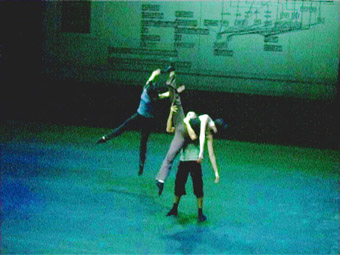 |
Dis-Patch |
Performer Darren Anderson is central to the third piece, Your sky is filled with billboards of the sky. Clad in a MIBURI body suit fitted with electronic sensors, his gestures are translated in real time by these sensors, controlling the musical elements and mixing the video component, including a live camera feed of the performance. This piece is prefigured by a long description of the technology involved, a tactic that tends to overshadow the act of witnessing it. Described as an exploration of “identity in the context of a world increasingly comprised of mediated experiences”, the piece remained, for me just another mediated experience—an intellectual exercise rather than a visceral one.
The title piece Dis-patch was the major work of the evening, also introduced with a lecture-like preamble which represented an unnecessary attempt to authenticate what was to come. In this work the architecture of choreography was transposed into composition. Applying orange and green ultraviolet paint directly onto the body, a hulking figure masked in black cloth transforms before our eyes into a skeleton, then into (a) man. There is an almost primitive quality to this performance, the clash with technology bringing to mind Frankenstein’s monster with all of its associations.
Meanwhile the female dancers, Tracy Holden and Elise May, look like they’ve been fashioned from the stuff of the black box space as they progressively alter parts of their costumes, constantly exiting and re-entering, generating enormous flux and energy. It is in this combination of costume design, movement, image and a soundscape that buzzes the speakers and rattles your chest that all the elements combine to create a dazzling and compelling experience. Jonathan Mustard’s score sets its own mood, while maintaining the centrality of the performers’ movements.
The final moments of the piece are startling, with audience and performers under house lights and the dancers in rehearsal clothes while the user interface is projected onto the screen behind them. The scene was touching and revelatory. Here, as the credits roll, we witness the effort and flesh of the dancers’ work.
Dis-Patch, choreographer Chrissie Parrott, composer Jonathan Mustard, music and video Jonathan Mustard, Lindsay Vickery; dancers Darren Anderson, Tracy Holden, Elise May; The Loft, QUT Creative Industries Precinct, June 22-26
RealTime issue #62 Aug-Sept 2004 pg. 38
© Leah Mercer; for permission to reproduce apply to [email protected]








 back
back